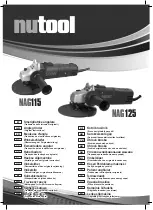
-25-
Wire Brush (Wheels and
Cups)
W i r e b r u s h e s a r e i n t e n d e d t o “ c l e a n ”
structural steel, castings, sheet metal,
s t o n e , a n d c o n c r e t e . T h e y a r e u s e d t o
remove rust, scale, and paint.
A v o i d b o u n c i n g a n d
snagging the wire brush,
especially when working corners, sharp
edges etc.
This can cause loss of control
and kick-back.
1. Allow the tool to reach full speed before
touching the tool to the work surface.
2. Apply minimum pressure to the work
surface, allowing the tool to operate at
high speed.
3. Continuously move the tool at a moderate
speed to avoid creating gouges in the
work surface.
4. R e m o v e t h e t o o l f r o m w o r k s u r f a c e
before turning tool off. Allow the tool to
stop rotating before laying it down.
Tip:
The tips of the brush do the work.
Operate wire brushes with the lightest
pressure so only the tips of the wire come
in contact with the work piece. If heavier
p r e s s u r e s a r e u s e d , t h e w i r e s w i l l b e
overstressed, resulting in a wiping action
and a shortened brush life due to wire
fatigue. Applying the side or edge of the
brush to the work piece will result in wire
breakage and shortened brush life.
Operating Instructions
WIRE CUP BRUSH
CORRECT:
Wire tips
doing
the work.
INCORRECT:
Excessive
pressure can
cause wire
breakage.
WIRE WHEEL BRUSH
CORRECT:
Wire tips
doing
the work.
INCORRECT:
Excessive
pressure can
cause wire
breakage.
160992A61E 08-21 GWX18V8.qxp_GWX 9/1/21 8:29 AM Page 25
















































